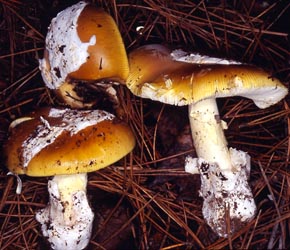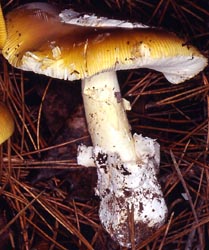|
[ Section Caesareae page. ]
[ Amanita Studies home. ]
[ Keys & Checklist/Picturebooks ] "Ballen's False Caesar" =Amanita calyptrata Peck non Lam. =Amanita lanei (Murrill) Sacc. & Trott.
Technical description (t.b.d.) BRIEF DESCRIPTION: The cap of Amanita calyptroderma is 100 - 160 mm wide, pale golden yellow near the margin, sun tan to bronze brown to darker gold or tannish yellow, ovoid at first to convex, tacky (not tacky when dry), satiny to dull, with a striate margin (5 - 15% of the radius), slightly decurved at first. The volva is present as a 1 - 8 mm thick white, membranous patch. The flesh is yellowish to creamy white. The gills are free, subcrowded, ivory white to pinkish white to dirty white, 10 - 11.5 mm broad, with a decurrent line on the stem. The short gills are rounded truncate to truncate and of diverse lengths. The stem is 139 - 155 × 21 - 40 mm, narrowing upward to cylindric, stuffed with white cottony material to hollow, white to pale yellowish, striate above ring, smooth below, with white fibrils and faint longitudinal striations. The ring is superior to subapical, skirt-like, membranous, pale yellow fading to white in age, with the lower edge at the midpoint of the stem. The saccate volva is membranous, with a felty texture on the outside, white on the inner and outer surfaces, broken in an irregular pattern, with a short inner limb. The spores of A. calyptroderma measure (8.6-) 9.0 - 12.0 (-24) × (5.5-) 5.8 - 7.0 (-8.5) µm and are inamyloid and ellipsoid to elongate, infrequently broadly ellipsoid or cylindric, very rarely bacilliform. Clamps are present at bases of the basidia. This species was originally described from Oregon (USA) and occurs commonly in the Pacific coastal states of the US at the beginning of the rainy season (Autumn). The original description is puzzling because it describes the fruiting body as "green tinted." The late Dr. Harry Thiers and others have told me that infrequently they find a green tinted fruiting body of the present species. I have never seen such an example. Photographs of such a specimen accompanied by good annotations and well-dried material would be greatly appreciated by RET. It is interesting to pause in our discussion of this species and look at the original description of Peck's species -- in order to address the question "How green was it?"
The present species differs from stirpes Caesarea and Hemibapha because the subhymenium is not comprised of layers of inflated cells. Instead, it has a distinctly branched structure. It shares this structure with taxa from the southwestern USA that are usually called "caesarea" or "the spring calyptrata" or "calyptroderma" by local mycologists. The "spring calyptrata" or "spring calyptroderma" is easily differentiated from A. calyptroderma by its cap color (pale yellow), its weakly structured (nonmembranous) stem ring, and its odor of fish. I am very interested in receiving well-dried, well-illustrated, and well-documented collections of the present species and this spring species. In the present species, the inner limb of the volva remains as yellowish fragments on the stem. In other species that may be confused with A. calyptroderma, the inner limb of the volva remains somewhat coherent and projects from the stem at an approximate right angle -- looking like a "ragged, secondary, lower ring." I am very interested in receiving well-dried, well-illustrated, and well-documented collections of taxa similar to A. calyptroderma, but of the latter form. Knowing of these other taxa with a similar subhymenium, coloring, and habit, I tentatively propose the stirps Calyptroderma to include them. The stirps is defined as follows: Subhymenium branched and including incompletely inflated cells at maturity -- not comprising layers of inflated cells (not suggesting cells of plant tissue). Stem bearing a membranous ring or (in one taxon) a thick subfelted to felted apical layer. Basidia bearing clamps. Volva membranous, rather thick, white, with a subfelted to felted to submembranous, and usually pigmented extension on the volva's internal limb that is usually deposited in some manner on the stem during expansion. Pileus not umbonate, thick fleshed, with proportionately short marginal striation. Pileus color white or including tints of red, orange, or yellow, at least at first, with color sometimes changing from exposure to sunlight. -- R. E. Tulloss Photos: Ron Pastorino (California).
[ Section Caesareae page. ]
[ Amanita Studies home. ]
[ Keys & Checklist/Picturebooks ] Last changed 8 October 2009. |

